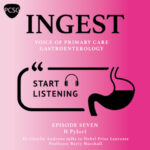H. Pylori

This edition of the podcast series Ingest published by the Primary Care Society for Gastroenterology (PCSG) features a very special guest from the world of gastroenterology.
Dr Charlie Andrews talks to Nobel Prize laureate Professor Barry Marshall, the Director of the Marshall Centre founded in 2007 in his honour, the Western Australian Ambassador for Life Sciences and University of WA Brand Ambassador, about his discovery of the bacterium Helicobacter pylori and its role in gastritis and peptic ulcer disease.
Key Learnings from the Podcast
What is Helicobacter pylori?
- H. pylori is a microaerophilic bacterium that resides in the mucous layer of the stomach lining, not invading the bloodstream, which explains why even immunosuppressed patients do not develop sepsis from it.
- It is classified as a Class 1 carcinogen by the WHO due to its established role in gastric cancer, and it is a primary cause of gastritis and peptic ulcer disease, alongside NSAID use[1].
Historical Context and Impact
- The discovery of H. pylori by Marshall and Warren in the early 1980s overturned the previous belief that the stomach was sterile and that ulcers were caused mainly by stress or lifestyle factors.
- Their work demonstrated that a common bacterial infection was the main cause of most gastritis and peptic ulcer disease, leading to a dramatic decline in ulcer surgeries and transforming ulcer management[1].
- The link between H. pylori and gastric cancer was established epidemiologically: areas with high H. pylori prevalence have higher rates of stomach cancer[1].
Diagnosis in Primary Care
Available Tests:
| Test Type | What it Detects | Pros & Cons |
|---|---|---|
| Serology (Blood) | Antibodies to H. pylori | Highly sensitive; good for ruling out H. pylori if negative; can remain positive after eradication, so less useful for confirming active infection[1]. |
| Urea Breath Test | Active infection | Highly specific for current infection; preferred in Australia for confirmation; fewer false positives[1]. |
| Stool Antigen Test | Active infection | Also highly specific; convenient for children; widely used in UK primary care[1]. |
- Best Practice: Use stool antigen or breath test to confirm active infection, especially before starting eradication therapy. Serology is useful as a rule-out test-if negative, H. pylori infection is unlikely[1].
- Caveat: Serology may remain positive for a year or more after eradication, so it should not be used to confirm cure or active infection[1].
Treatment Considerations
- Once diagnosed, H. pylori infection is treatable with antibiotics, which is satisfying for both clinicians and patients as it offers a clear cure pathway[1].
- There is ongoing debate about whom to treat: treat symptomatic patients (e.g., with ulcers or dyspepsia) rather than universally treating all who test positive, especially given increasing antibiotic resistance[1].
- The advent of proton pump inhibitors (PPIs) combined with antibiotics in the 1990s significantly improved cure rates, making outpatient management by GPs routine[1].
Epidemiological Trends and Clinical Implications
- The prevalence of H. pylori has declined in developed countries, but remains high in some regions and populations.
- In the current era, not all ulcers are due to H. pylori-NSAID-induced ulcers are now common, and gastroesophageal reflux disease (GERD) is more prevalent in Western countries[1].
- A careful history (birthplace, family history of ulcers, etc.) can help estimate H. pylori risk before testing[1].
Summary Table: Key Points for Primary Care
| Key Learning | Clinical Implication |
|---|---|
| H. pylori is a major cause of gastritis, peptic ulcer, and gastric cancer | Test and treat in appropriate symptomatic patients |
| Use stool antigen or breath test for active infection | Avoid unnecessary antibiotics by confirming active infection |
| Serology is useful for ruling out infection, not for confirming cure | Negative serology effectively excludes H. pylori |
| Declining prevalence in developed countries | Consider other ulcer causes (NSAIDs, GERD) in differential |
| Treatment has dramatically reduced ulcer surgery and gastric cancer rates | Early identification and management is effective and impactful |
Conclusion
Primary care clinicians should be aware that H. pylori is a common, treatable cause of significant gastrointestinal disease. Accurate diagnosis relies on appropriate use of stool antigen or breath tests, with serology reserved for ruling out infection. Treatment decisions should be guided by symptoms, risk factors, and confirmation of active infection to maximize benefit and minimize unnecessary antibiotic use[1].
Sources
[1] transcript-H.-Pylori.pdf https://ppl-ai-file-upload.s3.amazonaws.com/web/direct-files/attachments/46534945/266509fd-919b-46db-8206-66d9d4cced89/transcript-H.-Pylori.pdf
